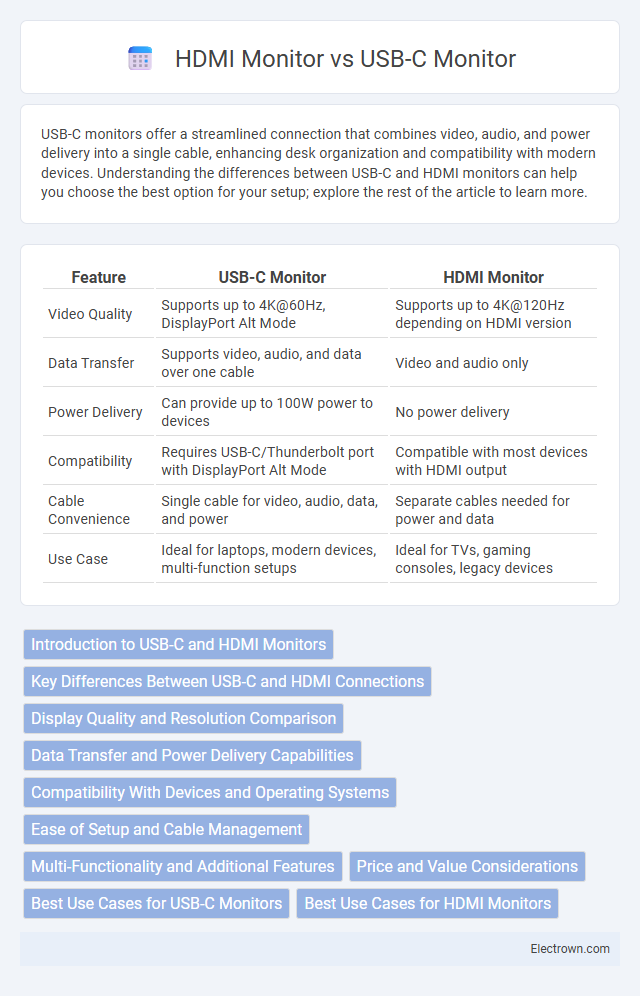USB-C monitors offer a streamlined connection that combines video, audio, and power delivery into a single cable, enhancing desk organization and compatibility with modern devices. Understanding the differences between USB-C and HDMI monitors can help you choose the best option for your setup; explore the rest of the article to learn more.
Table of Comparison
| Feature | USB-C Monitor | HDMI Monitor |
|---|---|---|
| Video Quality | Supports up to 4K@60Hz, DisplayPort Alt Mode | Supports up to 4K@120Hz depending on HDMI version |
| Data Transfer | Supports video, audio, and data over one cable | Video and audio only |
| Power Delivery | Can provide up to 100W power to devices | No power delivery |
| Compatibility | Requires USB-C/Thunderbolt port with DisplayPort Alt Mode | Compatible with most devices with HDMI output |
| Cable Convenience | Single cable for video, audio, data, and power | Separate cables needed for power and data |
| Use Case | Ideal for laptops, modern devices, multi-function setups | Ideal for TVs, gaming consoles, legacy devices |
Introduction to USB-C and HDMI Monitors
USB-C monitors integrate a single-cable solution that supports video, audio, data transfer, and power delivery, making them ideal for modern laptops and devices with USB-C ports. HDMI monitors are widely compatible and primarily designed for high-definition video and audio transmission, commonly used in gaming, media, and traditional computer setups. Choosing between USB-C and HDMI monitors depends on device compatibility, required data transfer speeds, and convenience of connection.
Key Differences Between USB-C and HDMI Connections
USB-C monitors offer a single-cable solution that supports video, audio, data transfer, and power delivery, making them ideal for streamlined setups and reducing cable clutter. HDMI monitors primarily focus on high-definition video and audio transmission, widely compatible with various devices but lacking data transfer and power capabilities. Your choice depends on whether you need a versatile connection for multiple functions with USB-C or a straightforward, widely supported video/audio interface with HDMI.
Display Quality and Resolution Comparison
USB-C monitors often support higher resolutions and faster refresh rates due to their ability to carry DisplayPort signals, enabling 4K at 60Hz or even 5K displays with HDR support. HDMI monitors vary depending on the HDMI version; HDMI 2.0 typically supports 4K at 60Hz while HDMI 1.4 is limited to 1080p or lower resolutions with slower refresh rates. Your choice between USB-C and HDMI monitors should consider the resolution and color accuracy demands of your workflow, with USB-C offering more future-proof options for high-quality display output.
Data Transfer and Power Delivery Capabilities
USB-C monitors offer superior data transfer speeds and power delivery capabilities compared to HDMI monitors, supporting up to 10 Gbps transfer rates and delivering up to 100W of power through a single cable. HDMI monitors primarily focus on video and audio transmission, lacking power delivery and offering lower data transfer speeds limited to display signal requirements. You benefit from reduced cable clutter and faster connection speeds with USB-C monitors, enabling seamless integration of video, data, and power in one cable.
Compatibility With Devices and Operating Systems
USB-C monitors offer broad compatibility with modern laptops, tablets, and smartphones that support DisplayPort Alt Mode or Thunderbolt 3/4, ensuring seamless connectivity and power delivery through a single cable. HDMI monitors maintain widespread compatibility across virtually all devices, including older PCs, gaming consoles, and media players, supporting a range of resolutions and refresh rates without requiring adapters. Operating systems like Windows, macOS, and Chrome OS natively support both USB-C and HDMI, but USB-C's versatility often enhances plug-and-play functionality by integrating video, audio, and data transfer alongside charging capabilities.
Ease of Setup and Cable Management
USB-C monitors simplify setup by combining video, audio, and power delivery into a single cable, reducing clutter and enhancing cable management. HDMI monitors require separate power and video cables, often leading to tangled wires and more complex setups. Using USB-C technology streamlines workspace organization and speeds up connection processes, making it the preferred choice for efficient cable management.
Multi-Functionality and Additional Features
USB-C monitors offer multi-functionality by combining video, power delivery, and data transfer through a single cable, reducing clutter and enhancing workspace efficiency. HDMI monitors primarily focus on video and audio transmission, lacking integrated power delivery or data connectivity features. Your setup benefits from USB-C's capability to connect laptops, smartphones, and other devices seamlessly while enabling charging and peripheral connections simultaneously.
Price and Value Considerations
USB-C monitors often come at a higher price point due to their advanced connectivity features and ability to deliver power, video, and data through a single cable, offering substantial value for users seeking minimal clutter and convenience. HDMI monitors generally cost less and remain a solid choice for those prioritizing affordability and widespread compatibility without the need for integrated charging or data transfer. Your decision should weigh whether the premium for USB-C connectivity aligns with your use case and budget, balancing cost against the enhanced functionality it provides.
Best Use Cases for USB-C Monitors
USB-C monitors excel in modern work environments where single-cable convenience for video, power delivery up to 100W, and data transfer are essential, such as connecting laptops, tablets, and smartphones with USB-C ports. Their ability to simplify cable management makes them ideal for remote workers, creative professionals, and mobile users who require seamless docking solutions. Your productivity improves when using USB-C monitors for multitasking setups, high-resolution displays, and fast charging combined in one compact connection.
Best Use Cases for HDMI Monitors
HDMI monitors excel in high-definition video and audio transmission, making them ideal for gaming, streaming, and home theater setups where multimedia quality is paramount. Their widespread compatibility with numerous devices like gaming consoles, Blu-ray players, and older laptops ensures seamless connectivity. You benefit most from HDMI monitors when prioritizing rich audiovisual experiences and compatibility with traditional entertainment equipment.
USB-C Monitor vs HDMI Monitor Infographic

 electrown.com
electrown.com